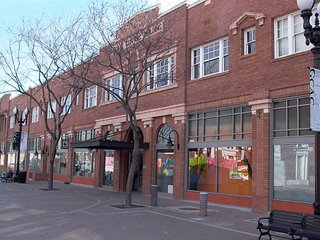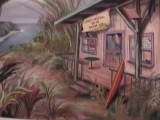I had a question about internships that I thought I'd answer. None of you will encounter this bridge for awhile, but I also know that students (and their parents/guardians) are also wondering about job prospects in the arts. So, it makes sense to ask about opportunities to get a first-hand experience in your selected industry while still a student. Passion supposedly fuels artists, but a paycheck every once in awhile certainly doesn't hurt. An internship is a first step towards that first paycheck.
A couple of the BFA programs require an internship in the industry, though any art major can arrange one. As you might guess, an internship is great way to learn "The Business" and begin networking with peers and professionals. One of the great advantages of CSUF's location is its proximity to one of the media capitols of the world--Los Angeles. The high density of small and large companies within this industry located nearby means you've got your pick of assignments among the major players in animation, graphic design, and illustration.
You may have heard about individuals getting an internship, which was nothing more complicated than answering telephones and taking messages for some executive. You won't hear that story from any of our students. Whatever your concentration, as an intern you will be applying every day you're on the job the tools you've developed in the classroom.
Dana Lamb, a professor in the animation program, coordinates the department's internship program. I have pasted below his FAQ on internships. Here is a link to a statement from a CSUF alumnus (Justin Ridge) who's working at LucasFilm right now. Justin recognizes Dana as one of his mentors.
DANA LAMB KUDOQ.) What are the pre-requisites for the 495 Internship Course?
A.) You must be in your junior or senior year and be a registerd BFA major in your discipline.
Q.) How do I find a company to work in as an intern?
A.) 1.) Register with the Career Center and Center For Internships on campus. They have a huge database of companies that need interns in all areas. 2.) Talk to your fellow students and find out where they did their internship. 3.) Look through the reports of past interns kept in the Art Dept. Office and copy down the names, phone numbers, and addresses of potential employers. 4.) Research companies in your major on the web 5.) Be innovative, go to trade magazines for your discipline, call on companies and ask their advice, be aggressive, this is your life and future!
Q.) When should I start looking?
A.) Ideally, at least one month before you are registered to begin your internship class. Plan on sending your resume and cover letter to at least 20-30 companies so you have many options to choose from and aren’t forced into taking the first internship you are offered.
Q.) How many hours do I commit to?
A.) You are required to complete a minimum of 150 hours during the semester. You may work more than that, but any less and you may not pass the course.
Q.) Do I ask to be paid for my work as an intern?
A.) Yes. It is not required, however. Let’s say you have an opportunity to work in a prestigious company that will look particularly impressive on your resume and/or will help you make contact with leaders in your field. Although they may not pay their interns, keep in mind that this opportunity may help you advance farther and at a quicker pace in the long run as you build your career.
Q.) How much money should I ask for?
A.) Companies that pay their interns are generally comfortable with $7-$12 an hour. Remember, learning to negotiate your wages and work benefits are part of the learning experience.
Q.) Any tips on meeting with a potential internship employer?
A.) Here are a couple:
1.) Do as much research about the company as possible. Know what they do, projects they have worked on, awards they have received, find out who’s-who in the company if at all possible. They will be flattered and impressed.
2.) Present your work in an organized, professional fashion. Cluttered, messy work that is presented out of sequence shows a lack of respect for the interviewer and an equal lack of respect for your own work.
3.) Put in only your best work, don’t show them everything you ever made since grade school, only the most professional-looking projects that you have completed.
4.) Quality, not quantity. They don’t have time to look at 30-50 projects. By the first 15 they will have determined whether you know your stuff. (Average portfolio has about 12-24 pieces.)
5.) Dress for success. You don’t have to look like a banker, but leave the college-dorm look at home. Chewing gum, headphones, heavy metal t-shirts, or beer breath won’t impress anyone.
6.) Don’t talk too much. It’s easy to start babbling, so try to let the work speak for itself. Don’t apologize for or point out weaknesses in your portfolio. Pick out your best stuff and let it do the talking.
7.) Prepare a list of questions based on your research about the company, it’s philosophy, it’s goals, etc. This will show that you know about them and have an eye on the future of their company.













